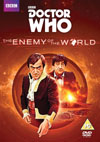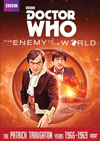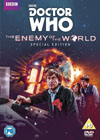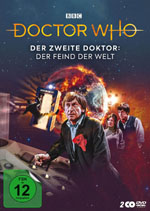The Enemy of the World
Pinch me, 'cause I'm still in shock from actually
seeing this long lost story in its entirety on DVD!
|
 |
 |
 |
DVD NTSC
Region 1




NEW for
May 20, 2014!
|
DVD PAL
Region 2


NEW for
Nov. 25, 2013!
|
CD Audio - 2 discs


|
|
(Doctor Who Story No. 40, starring Patrick Troughton)
- written by David Whitaker
- directed by Barry Letts
- produced by Innes Lloyd
- featuring a few classical library music tracks
- 6 episodes @ 25 minutes each
|
Story: Landing on a beach in Australia
in the 2010's, and quickly swept up in a deadly
spy game, the Doctor discovers that he is the
spitting image of a sly Latin-American politician
who is suspiciously rising to greater and greater
power. How is Salamander able to predict natural
weather disasters with such accuracy? Will Budapest
hand over control of the central European zone next?
And will the Doctor agree to impersonate Salamander
to discover the truth?
|
|
The DVD's include:
- Six digitally remastered complete original episodes! (#1,2,3,4,5,6)
- Coming Soon trailer for the DVD of "The Web of Fear" (the next story)
Buyers' Guide Review
by Martin Izsak
|
|
(A more in-depth analysis, containing "SPOILERS" and intended
for those who have already seen the program, can be accessed
here.)
|
This story represents a much needed relief from the monster-threat
base-defense formula that had taken over Doctor Who writing at this
period. It is a truly welcome breath of fresh air, as a
character-driven political thriller set in the near future, with a
doppelganger twist thrown in for Patrick Troughton. Unfortunately, it
does not turn out to be all that great a story. As with
"The Power of the Daleks" (story no. 30) before it and
"The Wheel in Space" (story no. 43) afterwards,
writer David Whitaker
focuses a little too much on characters, particularly ones who will
wallow in their own flaws, and not enough attention is paid to crafting
a solid, riveting on-screen plot.
Episodes one, two, and four seem to offer the best bits. The
action opening works fairly well on television, offering some unique visuals
for Doctor Who at this time, and incoming director Barry Letts makes
an impressive debut here. There's a good level of energy present on the
audio as well, but this is not as atmospheric or unique as other Doctor Who shows,
and in the novel the action opening comes off as rather boring reading.
Episode One really needs to be seen to be appreciated. Narratively, since nobody
knows who's Who yet, there's just too much confusion and silliness in
it for my liking.
As for the series regulars, the sequence raises a question that should
have remained resting in peace: why bother to step outside the TARDIS?
If you get to see the Doctor's beach antics, there's entertainment value here,
but if only reading or listening, curiosity is just not what it should be,
until much later on.
The doppelganger idea, combined with
careful character investigation, is pushed to the forefront of the
discussion. Add a threat and a surprise...... and
if this doesn't build good anticipation for
the rest of a story, nothing will! Great stuff.
Episode two continues nicely where the previous one left off,
and goes on to demonstrate much of the main scheme of the story,
which isn't too far off of some of the wilder
theories I've heard about Hurricane Katrina. Has reality been
inspired by fiction? Google the HAARP project, and you may see some
disturbing parallels. In this Doctor Who story at least,
we get a nice twist of sci-fi elements on a grand scale,
deftly used by those who have something to gain here.
A classic ploy, making for good drama
here as it usually does wherever it is used.
Episodes one and two (particularly two) are also notable for their use
of complex visuals composed of layers of elements, this time through using
a back-projection system with a pre-filmed insert playing behind the actors
in the video studio. Though much of the studio material featuring in this
era of Doctor Who is almost claustrophobic in its use of tiny spaces
(and stories like "The Web of Fear" play on this to their own atmospheric advantage),
"The Enemy of the World" takes a different tactic in artificially blowing the space
open with these trick shots. Very nice, and thoroughly more appropriate for this story.
It's easy to see how this story's director Barry Letts would go on to become
such a strong advocate of the BBC's then-experimental CSO chromakey process when
he takes over as producer in the colour era of the early 1970's. But apart from
some very interesting model work debuting in episode four, the visuals for
"The Enemy of the World" seem to be decidedly less complex and inspiring in the
following episodes.
 |
Episode three - previously the only surviving episode that you could
watch instead of just listen to - is largely okay, proceeding logically from
the consequences of the previous instalment, but not being entirely
understandable all on its own. The acting is of a high quality
by all participants, and of course Patrick Troughton's indulgence
in his new alter-ego role is first-rate and very enjoyable to watch.
Unfortunately, this leaves the Doctor with virtually nothing to do
in episode three, and he spends half
of his sole remaining scene hiding under the scenery.
What's worse, the dialogue explaining Denes's situation is too
little and goes by too quickly to make an impression on those who hadn't
seen previous episodes - the lack of reprise of episode two's last
scene adds to this problem.
David Whitaker once more allows our protagonists to use heaps of
dishonesty to try to solve their problems, while he and his characters
both seem blissfully unaware that this is what is getting them into
more and more trouble again and again.
But worse, episode three's most built-up story beat then goes without
resolution in the final episode three product. This is not the work of
Australian censors; this time around director Barry Letts cut
the vital scene himself. Thus episode three virtually commits
its own suicide of quality.
|
Music is virtually non-existent in episode three, which
barely adds more than a dash to Denes's dinner along with the salt.
It's not bad, but I can't say that it works well either - it somehow
manages to seem out of place. Other episodes fare better, with
episode one's action sequence getting good backing, and Bela Bartok's
lovely piece used for many scenes in the final
three episodes. Douglas Camfield is about to steal
that latter piece along with the Cybermen's
unofficial Space Adventure theme for the next story.
Many of the cliffhangers in this story are fairly well written,
but don't seem to have much dramatic punch to them in the way they
were realized on screen. Episode three's cliffhanger is really the
only one that actually seems to work well for me.
The episode hangs off as it
builds enormous anticipation for a juicy, dicey
political intrigue conflict to follow, which is great. Unfortunately,
nothing of the sort actually follows, making one wonder:
Where's the plot? The audio (and now video) of episode four reveals
something that must have been cut from the novelization,
but of course we'll only reveal that in the
in-depth analysis version of this review.
But episode Four is not lost at all, what with yet another fresh
new sci-fi element getting thrown in and explored. Excellent stuff!
Character motivation is very questionable though,
and not explained well in the novel at all. The
publishers pared Ian Marter's novel down far too much, but even so,
I don't believe the right stuff was in the television script to begin
with. At least at this point, one can still believe that
all the various motivations will become more obvious in later
episodes when the time is right to play certain cards.....
Frazer Hines and Deborah Watling take a holiday, and Patrick
Troughton makes up for their absence well by providing enough of
an active, heroic Doctor and a sci-fi-concept-and-character-revealing
Salamander to keep the ball rolling full steam ahead. A few questions
are answered surrounding one key character between this episode's
cliffhanger and the next one's first scene, and a few more questions
about other characters are raised. The story is definitely still
strong at this point.
"The Enemy of the World" falls apart in the final two episodes.
Patrick Troughton doesn't really get enough of the right things to do
in either of his two roles, as the plot becomes padded and has little
idea of where it is going. Again, I think Whitaker himself got so
absorbed in the lies that his various characters had told, he forgot
what the truth about the situation was half of the time, and pursued
too many distractions from what should have been the main plot.
The Doctor should be
Salamander's biggest concern, and vice-versa, but this is instead still
being ignored by the script and tip-toed around by the production
team, likely wary of their limits in realising Troughton's double role.
As if that wasn't bad enough, the film camera eventually
chewed up half of the split-screen material, and the long-awaited
meeting of hero and villain in this story is too short and
anti-climactic to really deliver on what had been set-up in earlier
parts of the story. At least these days we can continue on to watch the next
episode and most of the next story, which does at least deliver a half-decent
bit of explanation and payoff.
On video, the story seems to have a decent energy to it that
keeps the pace up much better than in the audio-only CD version or
in the novelization, which helps to mask some of the inadequacies of
plot or character motivation, and the first five episodes seem to move
along entertainingly enough. But quality does seem to decline as one goes
along, and the last episode falls apart quite a bit.
As a very recently re-discovered story, this one has been rushed through restoration
and onto DVD release quite quickly, without any real extras on the DVD at all. Though
the ability to finally watch the entire story will be attractive enough to many
die-hard fans to get them to buy this one, I'm always going to be a bit sorry that
it wasn't re-discovered several years earlier, such that its late director Barry Letts
could have participated in a set of audio commentaries and interviews, and had a unique
interaction with the Troughton era regulars to counterpoint all the excellent ones he
has had with those from his own Pertwee era team.
This fantastic concept for a story just doesn't seem to have been
done true justice at any stage: scripting, production, film archiving
at the BBC, or novelizing. ...Or now DVD special features. That said,
it does work considerably better when one can view the entire story, and
it has enough points of merit to it that it might just be able to successfully
challenge some of its closest rivals in season five's ranking. However, its
sloppy ending still hangs like a dead albatross around its neck.
The idea for the story is great, and dramatic anticipation
is built up extremely well, but like so many season two offerings, it
fails to deliver in the end.
"The Enemy of the World" USED TO BE a story with most of its episodes missing....
Now ALL of the episodes have been recovered, making this yet another rare COMPLETE
Patrick Troughton story.
All six episodes have undergone film restoration, and are now available
on DVD!
 |
 |
 |
DVD NTSC
Region 1 U.S.


NEW for
May 20, 2014!
|
DVD NTSC
Region 1 Canada


NEW for
May 20, 2014!
|
DVD PAL
Region 2 U.K.


NEW for
Nov. 25, 2013!
|
The DVD's include:
- Six digitally remastered complete original episodes! (#1,2,3,4,5,6)
- Coming Soon trailer for the DVD of "The Web of Fear" (the next story)
|
| The complete story - Special Edition with extras: |
Will this special edition
ever get a proper
North American
release? |
 |
 |
DVD NTSC
Region 1 U.S.
Special Edition
|
DVD NTSC
Region 1 Canada
Special Edition
|
DVD PAL
Region 2 U.K.
Special Edition

NEW for
March 26, 2018
|
DVD PAL
Region 2 Germany
"Der Feind der Welt"
|
Special Edition DVD Features include:
- Six complete original episodes (#1, 2, 3, 4, 5, 6) - with even more digital remastering for 2018
- Plus extra features:
- Audio commentaries on all episodes including
Frazer Hines (Jamie),
Mary Peach (Astrid),
Milton Johns (Benik),
Gordon Faith (Guard Captain), and
make-up designer Sylvia James.
Moderated by Simon Harries.
- "Treasures Lost and Found" production featurette
with Hines, Peach, and
debuting actor David Troughton (Guard at Kanowa [and son of Patrick Troughton] ).
Investigated by Tobe Hadoke.
- "Recovering the Past" interview of Philip Morris,
revealing how he rediscovered the episodes in Africa.
- "Remembering Deborah Watling" featurette
- Pop-Up Production Note Subtitles by Martin Wiggins
- Photo Gallery
- DVD ROM .pdf material includes scripts for all six episodes.
 |
Doctor Who: Lost in Time - Patrick Troughton
2 DVD discs
(also included in Lost in Time Boxed Sets) |
Coverage on The Enemy of the World includes:
More details & buying options for "Lost in Time" DVD's
This audio CD set features the complete audio tracks of all
6 television episodes of this story, narrated by
actor Frazer Hines (who also played Jamie McCrimmon)
to help listeners follow what used to be visual aspects
of the story.
This version
is playable in any normal audio CD player.
 |
Doctor Who: The Troughton Years
introduced by Jon Pertwee
1 VHS video tape |
Coverage on The Enemy of the World includes:
More details & buying options for missing episode VHS videos
Comments on this article are welcome. You may contact
the author from this page:
Contact page
|












